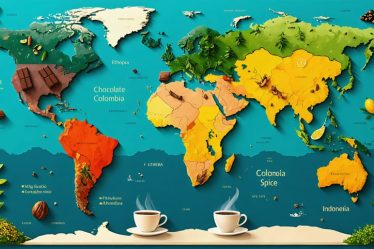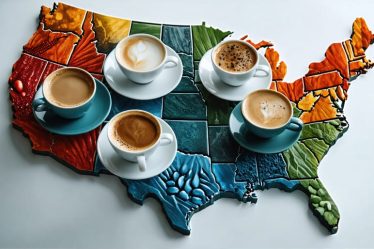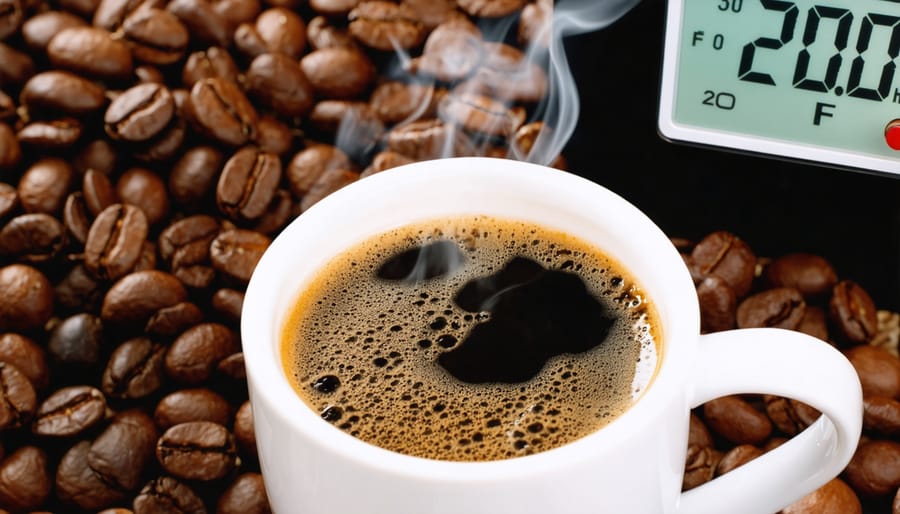
Pour water between 195-205°F (90-96°C) for optimal barista-quality coffee brewing, as this sweet spot extracts the perfect balance of flavors without burning the grounds. Just like baking the perfect cake, brewing temperature precision transforms your morning coffee from bitter disappointment to café-worthy perfection. Whether you’re a pour-over devotee or French press enthusiast, maintaining the right temperature throughout brewing unlocks hidden flavor notes and creates that velvety mouthfeel we all crave. I discovered this game-changing detail during my journey from coffee novice to home barista, and it’s amazing how such a simple adjustment can elevate your daily ritual. Let’s explore how to achieve the perfect brew temperature for your preferred method, ensuring every cup hits that sweet spot between too hot and too cool.
Why Temperature Matters for Your Coffee
The Science Behind Coffee Extraction
Have you ever wondered why your coffee tastes different at various temperatures? Let’s explore the fascinating world of coffee extraction chemistry in a way that’ll help you brew better coffee every time!
Think of coffee extraction like steeping a tea bag – different compounds are released at different temperatures. At lower temperatures (around 175°F), we mainly extract the delicate fruity and floral notes that give your coffee its brightness. As the temperature rises to 185-195°F, we start pulling out those lovely caramel and chocolate notes that make your morning cup so satisfying.
When water reaches the sweet spot of 195-205°F, we get the perfect balance of compounds – this is where magic happens! The oils, acids, and sugars work together to create that full-bodied flavor we all love. However, go too hot (above 205°F), and you’ll start extracting bitter compounds that can make your coffee taste harsh and unpleasant.
I learned this the hard way when I first started brewing at home – using boiling water straight from the kettle gave me some seriously bitter cups! Understanding these temperature zones has completely transformed my morning coffee routine.
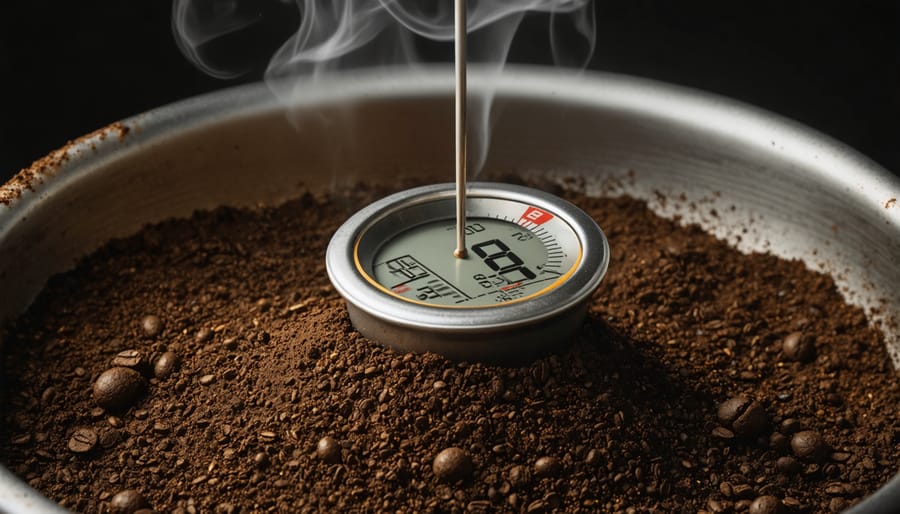
Flavor Profiles at Different Temperatures
Have you ever noticed how your coffee tastes different depending on the water temperature? Let me share what I’ve discovered through countless coffee experiments in my kitchen. When you brew coffee with water that’s too cool (below 185°F), you’ll get a slightly sour, underwhelming cup that lacks the full-bodied flavor we all love. It’s like the coffee hasn’t had the chance to reveal its true personality!
At the sweet spot between 195-205°F, coffee develops its rich, balanced character. The natural oils release perfectly, creating that heavenly aroma and bringing out delicate flavor notes like chocolate, nuts, or fruit. Think of it as giving your coffee beans their moment to shine!
Going too hot (above 205°F) is like overcooking a delicate dish – you’ll end up with bitter, harsh flavors that can overwhelm the coffee’s natural sweetness. Remember, great coffee is all about finding that perfect temperature balance for your personal taste preferences.
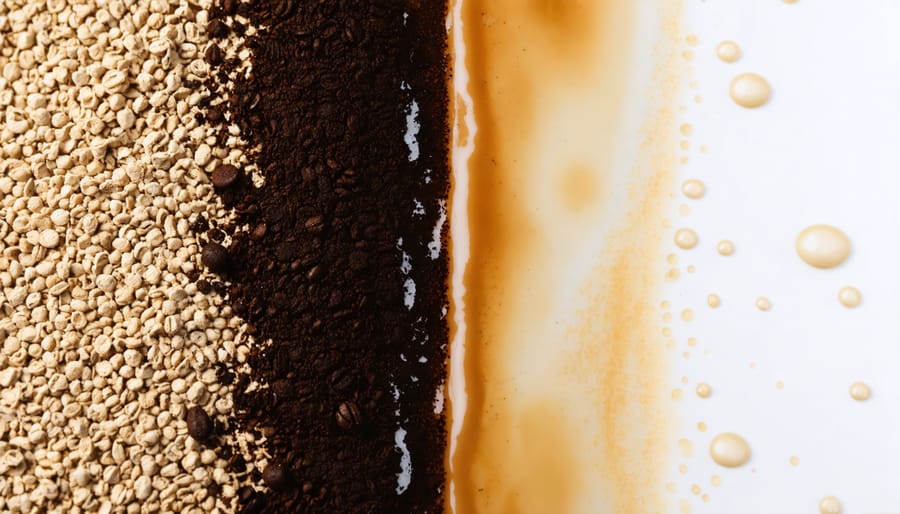
Finding Your Perfect Brewing Temperature
Drip Coffee and Pour-Over
For both drip coffee makers and manual pour-overs, the sweet spot for water temperature lies between 195°F and 205°F (90-96°C). I’ve found that this range brings out the perfect balance of flavors without any bitter notes. If you’re using a manual method with your pour-over brewing equipment, try starting at 200°F (93°C) and adjust based on your taste preferences. For light roasts, lean towards the higher end of the range to extract those bright, fruity notes. With darker roasts, stay closer to 195°F to avoid over-extraction and bitterness.
Remember to pre-heat your brewing vessel and filter with hot water – it’s a game-changer for maintaining the ideal temperature throughout the brewing process. If you’re using an electric drip maker, look for ones certified by the Specialty Coffee Association, as these machines are designed to maintain optimal brewing temperatures automatically.
French Press Perfection
Let me share a little secret from my own French Press journey: the perfect cup starts with getting the temperature just right. For this classic immersion method, you’ll want your water between 195°F and 205°F (90-96°C) – hot enough to extract those rich flavors but not so hot that you end up with a bitter brew.
Here’s a practical tip I learned from a barista friend: if you’re brewing without a thermometer, bring your water to a boil, then let it rest for about 30 seconds. This simple pause brings the temperature into that sweet spot we’re aiming for. For darker roasts, lean toward the lower end of the range (195°F), while lighter roasts shine at slightly higher temperatures (200-205°F).
Remember, consistency is key – keeping your French Press warm during the 4-minute steeping process helps maintain the ideal extraction temperature. I like to pre-warm my French Press with a quick hot water rinse before brewing.
Espresso Excellence
When it comes to pulling the perfect espresso shot, temperature precision is your best friend. I learned this the hard way after months of inconsistent results until I discovered the sweet spot: 195-205°F (90-96°C). This range allows for optimal extraction of those rich flavors and aromatic oils that make espresso so special.
Picture this: too hot (above 205°F), and you’ll end up with a bitter, burnt-tasting shot that makes you wince. Too cool (below 195°F), and your espresso will taste sour and underwhelming – trust me, I’ve been there! The ideal temperature brings out the natural sweetness and complexity of your beans while maintaining that perfect balance we all love.
Here’s a little tip I picked up from my favorite local barista: let your machine warm up for at least 15-20 minutes before brewing. This ensures temperature stability throughout the extraction process. If you’re using a PID-controlled machine (fancy, I know!), aim for 200°F (93°C) as your starting point and adjust based on your taste preferences and the specific beans you’re using.
Remember, every bean has its own personality – some shine at slightly higher temperatures, while others prefer it a touch cooler. Don’t be afraid to experiment within this range to find your perfect cup!
Common Temperature Mistakes (And How to Fix Them)
Signs Your Water is Too Hot
You know that disappointing moment when you take your first sip of coffee and it tastes bitter and burnt? I’ve been there too! When your water is too hot, it can seriously impact your coffee’s flavor, turning what should be a delightful morning ritual into a less-than-perfect experience.
The most obvious signs of overheated brewing water include overly bitter coffee, a burnt taste, and a lack of subtle flavor notes. If your coffee tastes harsh or leaves an unpleasant aftertaste that lingers longer than usual, your water temperature might be the culprit.
Here’s a quick way to check: if you see steam violently rising from your kettle or bubbles still actively forming, give it a minute to cool down. The ideal brewing temperature is just below boiling, around 195-205°F. When in doubt, wait about 30 seconds after your water boils before brewing.
For those using electric kettles without temperature control, try this simple fix: after the water boils, open the lid for about 30-45 seconds. This allows the temperature to drop to that sweet spot where your coffee’s best flavors can shine through.
When Your Coffee is Under-Extracted
Ever made a cup of coffee that tastes a bit weak or watery? I’ve definitely been there! Under-extraction often happens when your brewing temperature isn’t quite hot enough, but don’t worry – there are several easy fixes to get your perfect cup back on track.
First, check your water temperature before brewing. For most brewing methods, you’ll want it between 195-205°F (90-96°C). If you’re eyeballing it, wait about 30 seconds after your water boils before pouring. Too many of us make the mistake of using water that’s too cool, especially when we’re in a morning rush!
Here’s a quick fix I learned from my local barista: pre-heat your brewing equipment. Simply rinse your filter, carafe, or French press with hot water before brewing. This prevents heat loss during the brewing process and helps maintain that optimal temperature throughout.
If you’re using an electric coffee maker, consider descaling it regularly. Built-up mineral deposits can affect heating efficiency, leading to cooler brewing temperatures and under-extracted coffee. A monthly cleaning routine can make a world of difference in your coffee’s flavor.
Remember, great coffee is all about consistency, so once you find your perfect temperature, stick with it!
Tools for Temperature Control
Essential Temperature Tools
Getting the perfect brew starts with having the right tools in your coffee-making arsenal. Trust me, I learned this the hard way after countless cups of either lukewarm or scalding coffee! A reliable digital thermometer is your best friend here – I particularly love the instant-read ones that give you accurate readings in seconds.
For the ultimate convenience, consider investing in a temperature-controlled electric kettle. These smart little appliances let you set your desired temperature and maintain it, which is perfect for those mornings when you’re multitasking between getting ready and brewing your coffee. Some even come with preset temperatures for different types of coffee!
Don’t want to splurge on fancy equipment? A basic probe thermometer works just fine. The key is consistency – whatever tool you choose, stick with it and learn how it behaves. And remember, while these tools are helpful, they’re meant to guide you toward your perfect cup, not restrict your coffee-making journey.
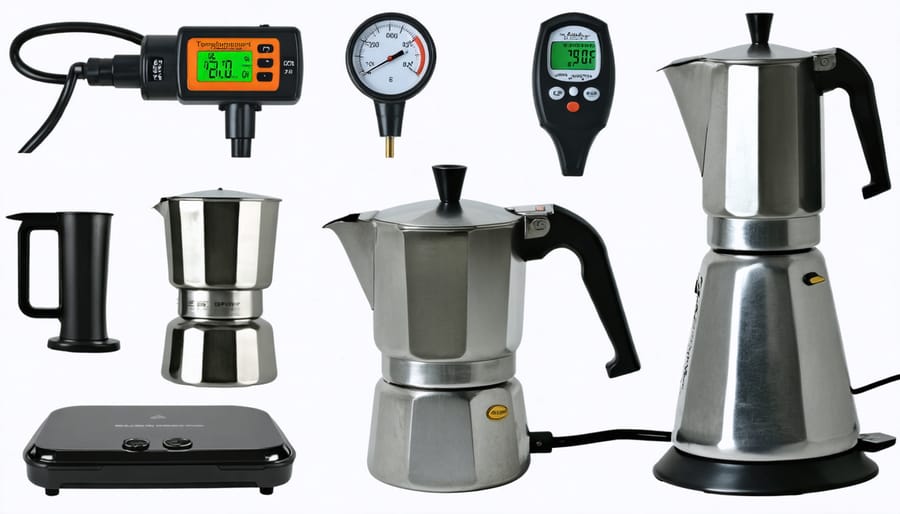
Temperature Control Tips
Getting the perfect brewing temperature doesn’t have to be complicated! I love using a digital thermometer – it’s been a game-changer in my morning coffee routine. For consistent results, pre-heat your brewing equipment by running hot water through it first. This simple step prevents temperature drops that can affect your coffee’s taste.
If you’re using a kettle without temperature control, try this handy trick: after boiling, let the water rest for about 30 seconds to reach that sweet spot between 195-205°F. For pour-over enthusiasts, keeping your carafe or mug warm makes a noticeable difference – I usually fill mine with hot water while grinding my beans.
Remember to store your beans at room temperature, as cold beans can lower your brewing temperature. And here’s my favorite tip: if you’re using a French press, wrap a kitchen towel around it during steeping. This little hack helps maintain the perfect temperature throughout the brewing process.
Now that you understand the importance of temperature in coffee brewing, it’s time to put this knowledge into practice! Remember, the sweet spot typically lies between 195°F and 205°F (90-96°C), but don’t be afraid to experiment within this range to find your perfect cup. Each coffee bean and brewing method might require slight adjustments to achieve the best results.
I’ve found that keeping a small brewing journal can be incredibly helpful in tracking your temperature experiments. Note down the temperature, brewing method, and your impressions of each cup. This way, you’ll discover your personal preferences and consistently brew coffee that brings a smile to your face every morning.
Start with the recommended temperatures we’ve discussed, and make small adjustments of 2-3 degrees at a time. Pay attention to how these changes affect the flavor, aroma, and overall experience of your coffee. Remember, there’s no absolutely “right” temperature – it’s about finding what works best for you and your favorite beans.
Happy brewing, coffee lovers! I’d love to hear about your temperature-testing adventures and the perfect brew you discover along the way.


